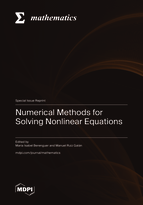Numerical Methods for Solving Nonlinear Equations
A special issue of Mathematics (ISSN 2227-7390). This special issue belongs to the section "Computational and Applied Mathematics".
Deadline for manuscript submissions: closed (31 March 2023) | Viewed by 14715
Special Issue Editors
Interests: applied mathematics; numerical analysis; fixed point theory; inverse problems; funtional analysis
Special Issue Information
Dear Colleagues,
As you know, many problems coming from several areas as medicine, biology, economics, finance or engineering can be described in terms of nonlinear equations or systems of such equations, which can take different forms, from algebraic, differential, integral or integro-differential models to variational inequalities or equilibrium problems, to name only a few. For this reason, nonlinear problems constitute one of the most fruitful fields of study in pure and applied mathematics.
However, usually there are not available direct methods allowing us to deal with their effective resolution. Hence the enormous interest in its numerical treatment.
This special issue is intended to collect recent advances in this area. The topics of interest for the special issue include, but are not limited to, NUMERICAL METHODS FOR SOLVING:
- Nonlinear differential equations.
- Nonlinear integral equations.
- Nonlinear integro-differential equations.
- Nonlinear variational equations.
- Nonlinear optimization problems.
- Nonlinear control problems.
- Equilibrium problems.
- Nonlinear algebraic equations.
In addition to all this, their applications to real-world are also especially welcome.
Prof. Dr. Maria Isabel Berenguer
Prof. Dr. Manuel Ruiz Galán
Guest Editors
Manuscript Submission Information
Manuscripts should be submitted online at www.mdpi.com by registering and logging in to this website. Once you are registered, click here to go to the submission form. Manuscripts can be submitted until the deadline. All submissions that pass pre-check are peer-reviewed. Accepted papers will be published continuously in the journal (as soon as accepted) and will be listed together on the special issue website. Research articles, review articles as well as short communications are invited. For planned papers, a title and short abstract (about 100 words) can be sent to the Editorial Office for announcement on this website.
Submitted manuscripts should not have been published previously, nor be under consideration for publication elsewhere (except conference proceedings papers). All manuscripts are thoroughly refereed through a single-blind peer-review process. A guide for authors and other relevant information for submission of manuscripts is available on the Instructions for Authors page. Mathematics is an international peer-reviewed open access semimonthly journal published by MDPI.
Please visit the Instructions for Authors page before submitting a manuscript. The Article Processing Charge (APC) for publication in this open access journal is 2600 CHF (Swiss Francs). Submitted papers should be well formatted and use good English. Authors may use MDPI's English editing service prior to publication or during author revisions.
Keywords
- nonlinear problems
- numerical methods
- differential, integral, integro-differential equations
- optimizacion problems
- variational equations
- control problems
- equilibrium problems
- algebraic equations







